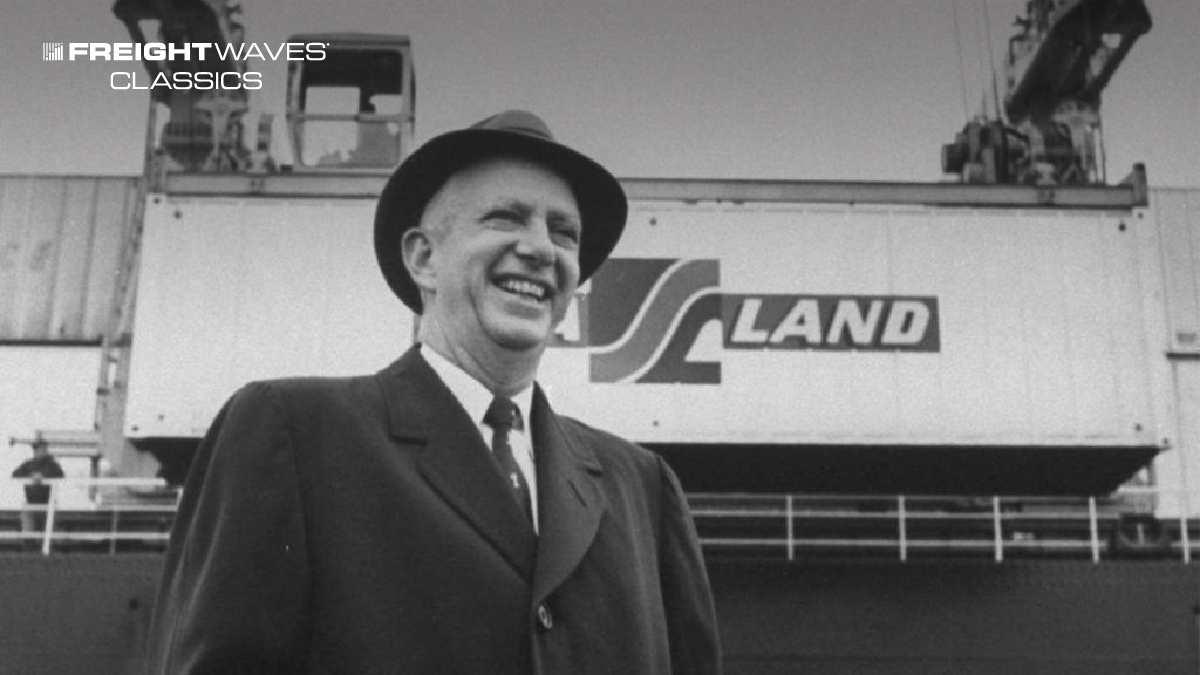FreightWaves Classics is sponsored by Old Dominion Freight Line — Helping the World Keep Promises. Learn more here.
The shipping container is one of the most influential inventions in the shipping industry. For better or for worse, it arguably paved the way for globalization and a new take on the supply chain and logistics industry simply by streamlining the loading and unloading process.
But where did the shipping container come from?
A man named Malcom McLean started a small trucking company focused on farming supplies in the 1930s to support his family during the Great Depression, according to PBS’ “Who Made America?” He was known for his resourcefulness and ability to tackle problems from a different angle than most people. Because of this, by the 1950s McLean Trucking grew to 1,700 trucks and was worth $12 million when McLean sold it.
One day while watching dockworkers loading and unloading shipments from truck to ship, McLean thought that there must be a more efficient way. At the time, it would take eight days on each end of a ship’s trip to load and unload cargo, according to American Business History.
McLean gained inspiration from railcars on ships to Cuba in 1929 and World War II experimentation with early ideas of small containers. He believed there was a new strategy waiting to be uncovered that would streamline operations, using a large container that would easily transfer from truck to ship. But others only saw government regulations, unions and workers who feared job loss, logistical issues and expense.
“His colleagues report that he could not see problems like others saw them — he took big issues and broke them down into components, which he attacked one at a time,” says American Business History.
The determined businessman realized that oil tankers traveled with empty top decks, added American Business History, which meant room for containers on top. So McLean bought an oil tanker, the Ideal X, added a steel deck to support the extra load and on April 25, 1956, sailed from Newark, New Jersey, to Houston. The ship transported 58 containers.

One anecdote says that while McLean marveled at the feat, a longshoreman had another opinion, remarking, “I think they ought to sink the sonofabitch.”
Officially, this is the first recorded successful container ship transport. And despite the naysayers, it paid off. McLean invested further in the idea of the containers and named a new company Sea-Land.
The Port Authority of New York opted to put in a new container port in Elizabeth, New Jersey, the first of many to come, according to PBS. Shipping became much faster due to the decrease in loading and unloading time. But it also became much more secure. The containers offered more security due to their concealed nature. There were many less opportunities for theft.
Eventually, the Vietnam War pushed container ports into Asia and imported consumer goods prices lowered thanks to the more efficient way of shipping. In 1969, McLean sold Sea-Land for $160 million. He continued to create more inventions, including a new way of transporting patients from a stretcher to a hospital bed and other shipping ideas, until he passed away in 2001 at age 87.
FreightWaves Classics articles look at various aspects of the transportation industry’s history. Subscribe to our newsletter!
Have a topic you want us to cover? Email [email protected].











Bill Goins
Joined Sea-Land In 1962 right out of college and in sales for next 16 years in Houston, Chicago, Philadelphia, Long Beach, Washington D.C. and back to Houston.
I met and worked with some really fine folks, and happy to have been a part of container shipping’s history.
Bill Goins